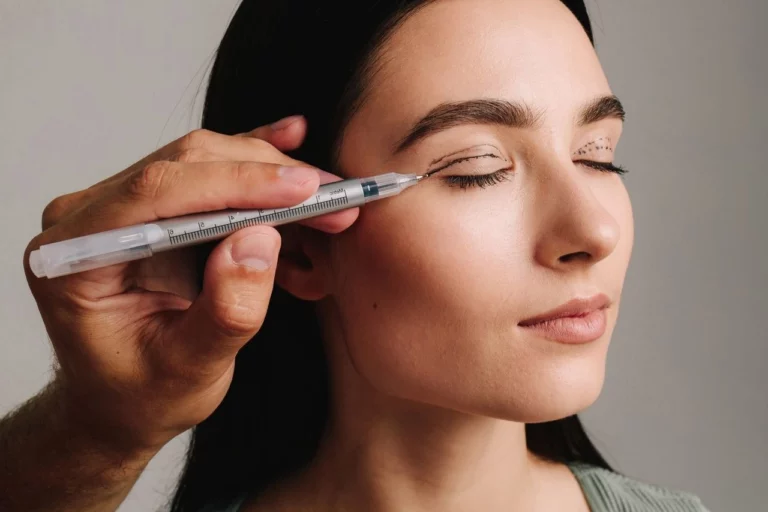How Is Blepharoplasty Done?
How Is Blepharoplasty Done?

Blepharoplasty is a sophisticated cosmetic procedure designed to rejuvenate the appearance of drooping eyelids. This delicate treatment removes excess skin, muscle, and sometimes fat that can accumulate around the upper and lower eyelids over time. As one of the most popular facial surgeries worldwide, blepharoplasty enhances aesthetic appearance and improves peripheral vision in cases where sagging impairs sight. The procedure requires meticulous attention to detail from a skilled surgeon who deeply understands eyelid anatomy. Let’s explore in greater detail how this surgery is performed.
Surgeries Techniques Based on The Type of Blepharoplasty Surgery?
Before eyelid modification, patients should understand that blepharoplasty isn’t a one-size-fits-all procedure. The surgical approach varies significantly based on individual anatomy, aesthetic goals, and functional concerns. Selecting the appropriate technique is crucial for achieving natural-looking results while addressing specific issues affecting the eye area. Here are three main types of blepharoplasty:
Upper Eyelid
Upper blepharoplasty focuses on removing excess skin and fat that can create a hooded appearance and sometimes impair vision. The surgeon typically marks the eyelid’s natural crease and makes a fine incision along this line, eliminating unwanted tissue while preserving the eye’s natural contour. This procedure rejuvenates the appearance by removing excess skin and expands the field of view for patients whose peripheral vision has been compromised by sagging upper lids.
Lower Eyelid
This procedure addresses under-eye bags, puffiness, and wrinkles that create a tired appearance. The surgeon may approach the lower area in different ways. Traditional transcutaneous techniques involve an incision just below the lash line, allowing access to remove or reposition fat deposits and trim excess skin. This approach suits patients with significant skin laxity and pronounced fat pockets. Surgeons carefully preserve the natural contour of the lower lid to prevent complications, such as tissue retraction or an unnatural appearance. There is also a transconjunctival method that does not require external incisions, which will be discussed later.
Double Eyelid
The double eyelid technique (a.k.a. Asian blepharoplasty) creates or enhances a crease in the upper eyelid. This specialized procedure is popular among patients of East Asian descent who may naturally have a single eyelid (monolid) and desire a more defined contour. Several methods exist, including suture techniques that create the fold without removing tissue, partial incision methods combining limited cutting with stitches, and full incision approaches for dramatic results. The surgeon carefully considers the individual’s facial harmony, ethnic features, and personal preferences when determining the ideal height and shape of the new crease. This procedure requires deep expertise to achieve natural results while respecting the patient’s cultural aesthetic.
Transconjunctival vs. Transcutaneous Techniques: What Is the Difference?
- Transconjunctival blepharoplasty addresses excess fat through an internal incision made on the inner surface of the eyelid, preserving the external appearance entirely. This technique is particularly beneficial for younger patients whose primary concern is fat protrusion rather than skin laxity.
- Transcutaneous blepharoplasty involves an external incision, typically placed just beneath the lash line to minimize visibility. This approach allows surgeons to remove or reposition fat while addressing laxity in the delicate eyelid skin that often accompanies aging. .
Blepharoplasty Surgical Procedure Overview
1. Anesthesia
Blepharoplasty begins with local anesthesia for the upper eyelid or under anesthesia for the lower or double eyelid.
2. Incisions
The surgeon creates precise incisions following pre-marked guidelines. For upper blepharoplasty, the cut is typically made in the natural crease, extending slightly beyond the outer corner of the eye when necessary to address lateral hooding. Lower eyelid incisions may follow one of two approaches:
- Externally along the lower lash line, which provides complete access to all tissue layers.
- Inside the eyelid when no skin removal is required.
The placement of these carefully designed incisions ensures they will be concealed within natural folds once healed. Dr. Jayaram uses specialized instruments to create the openings with minimal trauma to surrounding tissues, establishing the foundation for the subsequent surgical steps.
3. Fat Removal/Redistribution
4. Excess Skin and Tissue Management
After addressing the underlying fatty structures, the doctor focuses on other tissues. They determine how much excess eyelid skin can be safely eliminated without compromising function. This careful approach prevents complications like dry eye or incomplete closure due to too much removal. In addition, the surgeon may tighten the orbicularis oculi muscle to create a smoother contour. Throughout this process, the eyes remain protected with lubricating ointment. The surgeon periodically checks the appearance of the patient’s eyes in both open and closed positions, ensuring natural-looking results and proper function.
5. Suturing
The final phase involves meticulous closure of the incisions using ultra-fine sutures explicitly designed for the delicate eyelid tissues. These specialized stitches, often thinner than human hair, minimize scarring while providing secure sealing. Depending on the specific tissue layers, the surgeon may employ different suturing techniques (dissolvable and non-dissolvable). Each stitch is precisely placed to maintain the natural contour of the eyelid while distributing tension evenly along the incision line. Most sutures are removed within 5-7 days, though some surgeons opt for self-dissolving varieties that disappear themselves.
Dr. Jayaram Offers the Most Comfortable Eyelid Surgeries in California
Dr. Jayaram offers highly comfortable blepharoplasties, combining artistry with precision to deliver exceptional results. Her signature Ellevate Lid Lift is a breakthrough in reconstructive surgery, designed for maximum convenience with minimal downtime. This in-office procedure takes just 30 minutes, allowing patients to achieve youthful eyelids without the hassle of a hospital visit. Dr. Jayaram’s meticulous technique and artistic eye ensure every treatment enhances facial harmony while prioritizing patient comfort.
Conclusion
Blepharoplasty surgery offers a precise and effective way to rejuvenate the eyes, restoring a more youthful and refreshed appearance. Whether addressing excess skin, under-eye puffiness, or creating a defined eyelid crease, this procedure delivers natural-looking results with long-lasting benefits. Our advanced techniques, such as the Ellevate Lid Lift, help patients achieve beautiful outcomes with minimal downtime. We highly recommend consulting our experienced surgeon, Dr. Jayaram, to ensure a customized approach that enhances aesthetics and function.










